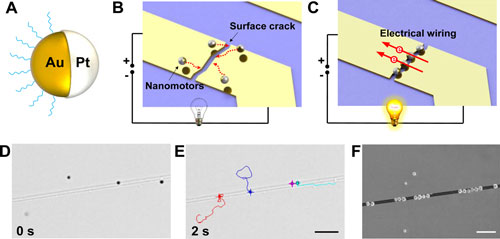| Posted: Sep 22, 2015 | |
Repair nanobots on damage patrol (w/video) |
|
| (Nanowerk Spotlight) You cut yourself in the finger – and a few days later your skin has completely healed all by itself. Biological organisms have an amazing ability to automatically initiate self-healing and self-repair when they sustain damage. Materials engineers are dreaming about making materials that could do the same thing. | |
| Inspired by the intrinsic self-repairing ability of biological systems, researchers have developed a class of artificial 'smart' materials – called 'self-healing materials' – which can repair internal or external damages (see for instance: "Self-healing hybrid gel system"); more recently they even developed an approach to self-healing electronic devices ("A magnetic-assisted, self-healing supercapacitor"). | |
| Many of these approaches depend on (a limited amount of) the healing agents being incorporated into the material or on external stimuli to initiate the repair process. Complicating the matter are damages that originate at the micro- or even nanoscale, such as cracks and tears in thin-films, membranes and electronic circuits. | |
| An ideal material and device self-healing system would be autonomous: damages would be detected, localized and repair initiated independent from outside interference and without the need for external control. | |
| "For a system to perform autonomous repair, it must be capable of delivering the healing agents precisely to specific defect sites," Joseph Wang, distinguished professor of nanoengineering at UC San Diego, tells Nanowerk. "Such healing agents must carry out the following three key functions: convert environmental energy into mechanical work for directed motion, autonomously sense and detect the damage, and possess engineered repairing capabilities." | |
| In new work, Wang's team, in cooperation with Prof. Anna Balazs' group at the University of Pittsburgh, have now engineered synthetic nanomotors that self-propel and autonomously detect surface cracks in electronic devices and rapidly restore the conductive pathway. | |
| The researchers reported their findings in the September 18, 2015 online edition of Nano Letters ("Self-Propelled Nanomotors Autonomously Seek and Repair Cracks"). | |
 |
|
| Schematic and actual process of autonomous repair of broken electronic pathways by artificial nanomotors that autonomously seek and repair microscopic mechanical cracks to effectively restore conductivity. (A) Structure of the functionalized Au/Pt Janus spherical nanomotor. (B, C) Nanomotor-based autonomous conductivity restoration concept. Localization of nanomotors at the crack site restores a conductive pathway, lighting up the light bulb. (D, E) Time-lapse microscopy images showing the nanomotors swimming and localizing in a surface crack within 2 seconds. (F) SEM image illustrating the spherical nanomotors confined in the crack. Scale bar: 5 µm. (Reprinted with permission by American Chemical Society) (click on image to enlarge) | |
| The team's nanomotors were inspired by the chemotaxis of neutrophils toward inflammation sites and the aggregation of platelets at the collagen fibers of a wound to stop bleeding. | |
| The catalytic nanomotors are composed of conductive gold/platinum spherical Janus particles that self-propel efficiently in the presence of hydrogen peroxide fuel. They convert this fuel into directed motion to autonomously seek the surface cracks on the substrate. | |
| "The presence of surface cracks introduce obstructions and gaps, which present both energetic barriers and potential wells to the random walk trajectories of the nanomotors," Wang explains the nanomotors' sensing mechanism. "The surface cracks act as potential wells, which confine and localize the nanomotors. | |
| He notes that these nanomotors can also spontaneously self-assemble into clusters that can travel as groups toward the damage location. | |
| By accumulating inside the cracks, the conductive nanomotors provide a 'patch' that restores the electrical current in the broken circuit. | |
| This video shows how originally dispersed swimming nanomotors gradually accumulate and aggregate into a surface crack. | |
| The clustering of nanomotors is primarily due to the hydrophobic coating on their hemispheric gold surfaces (a self-assembled monolayer of octadecanethiol). | |
| "Although the repair functionality demonstrated in this work involves the selective localization of conductive nanoparticles at cracked electrodes, the self-propelled nanomotor concept can be extended to repair the biological, mechanical, optical, or electronic properties of a wide range of damaged materials," says Wang. | |
| "The use of self-propelled nanomotors to probe nano- and microscale environmental changes and to promote autonomous and precise localization at desired sites opens the door for artificial responsive nanosystems with advanced biomimetic functionalities for a wide variety of applications ranging from targeted drug delivery to self-healing nanodevices," he concludes. | |
 By
Michael
Berger
– Michael is author of three books by the Royal Society of Chemistry:
Nano-Society: Pushing the Boundaries of Technology,
Nanotechnology: The Future is Tiny, and
Nanoengineering: The Skills and Tools Making Technology Invisible
Copyright ©
Nanowerk LLC
By
Michael
Berger
– Michael is author of three books by the Royal Society of Chemistry:
Nano-Society: Pushing the Boundaries of Technology,
Nanotechnology: The Future is Tiny, and
Nanoengineering: The Skills and Tools Making Technology Invisible
Copyright ©
Nanowerk LLC
|
|
|
Become a Spotlight guest author! Join our large and growing group of guest contributors. Have you just published a scientific paper or have other exciting developments to share with the nanotechnology community? Here is how to publish on nanowerk.com. |
|
